Frans Jat Ganobal, a man about 50 years old from the Ganobal clan in Lorang, Aru Tengah District, has a typical appearance of Eastern Indonesian descent. Calmly steering his “kedo-kedo” or a bout made of fiber propelled by a small outboard motor using solar fuel. His kedo-kedo moves forward not too fast, navigates along the narrow straits between islands, slightly tossed by the waves, and sways as he comes across other kedo-kedo, and sets out to catch mangrove crabs.
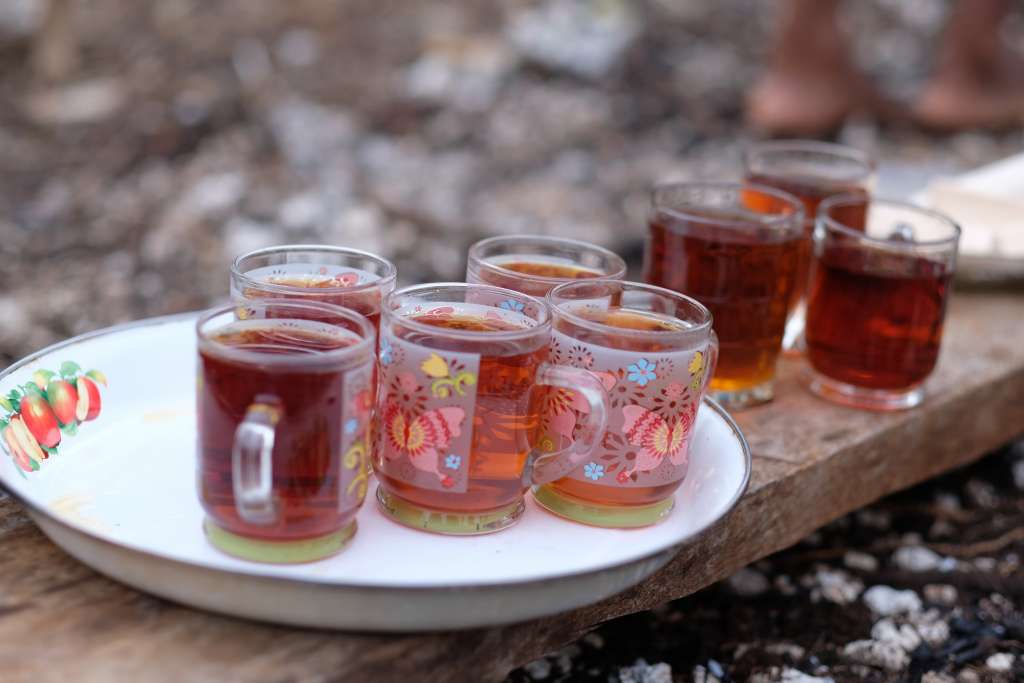

Arriving at the location where the “bubu” traps are set, Frans Jat turns off the motor, pulls the strings, and lifts the hooks that haven’t caught any fish. Then, he approaches and raises the submerged “bubu” traps tied to the mangrove roots. Unfortunately, luck isn’t on his side that day as none of the traps have caught any crabs.
The trap is raised onto the kedo-kedo. The mud and leaves inside are cleaned out. Half of the prepared grouper fish head prepared from home is then put into the trap. After it’s filled with bait and weighted with stones, it is submerged. To prevent it from shifting or drifting caused by the current, the trap’s end is connected to a fishing line tied to mangrove roots. Frans Jat’s trap, and those of others in Lorang, are typically made of rattan poles tied with rope, with the sides covered with nets.
Frans Jat explains that he usually sells crabs caught in his traps, ranging from 10 to 20 crabs per week. Not all crabs caught are sold to middlemen; only those weighing above 300 grams with hardened shells are sold.
The price varies according to weight. Currently, crabs weighing 300 – 700 grams are priced at 90 thousand rupiahs, those weighing 700 grams – less than 1 kg are priced at 180 thousand rupiahs, and crabs weighing more than 1 kg are priced at 280 – 300 thousand rupiahs. Unsold crabs are usually released back into the wild or kept for further breeding.
Mangrove crabs are one of the main marine commodities, besides seaweed, that provide income for the people of Lorang and the Aru community in general. The potential for crabs in the Aru Islands is abundant, supported by the well-preserved mangrove ecosystem on the small islands. Fisheries production data for the period 2020 – 2022 from the Aru Islands Fisheries Service shows an average catch of around 11.7 tons of crabs per year. The actual number could be higher as it is not fully recorded. For Lorang alone, middlemen who come every week can bring at least around 250 kg of crabs from the catch of Lorang residents.
The vast traditional territory of Lorang, which approaches 40 thousand hectares with 22 percent being mangrove ecosystems, is clearly a very suitable habitat for mangrove crabs to breed. From the number of mangrove crabs caught in Lorang every week and their lifespan of about 3-4 years, one can imagine the immense potential of mangrove crabs in Lorang. However, it is important to conduct further studies on the population dynamics of mangrove crabs in Lorang to minimize the occurrence of “over-catching” which could lead to a decline in crab catches in the future.
We continue our journey while ”nondak”. Not long after traversing the small straits, which are 3-5 meters wide and flanked by healthy natural mangroves, we arrive at a small elevated hut by the strait. The hut, measuring 3 x 4 meters, has walls made of wooden planks and a roof woven from sago leaves. Its floor is supported by four wooden beams, and there’s a ladder leading up, partially submerged in the mud to about half the calf’s depth of an adult. It seems that during high tide, some of the posts and steps are submerged by seawater.
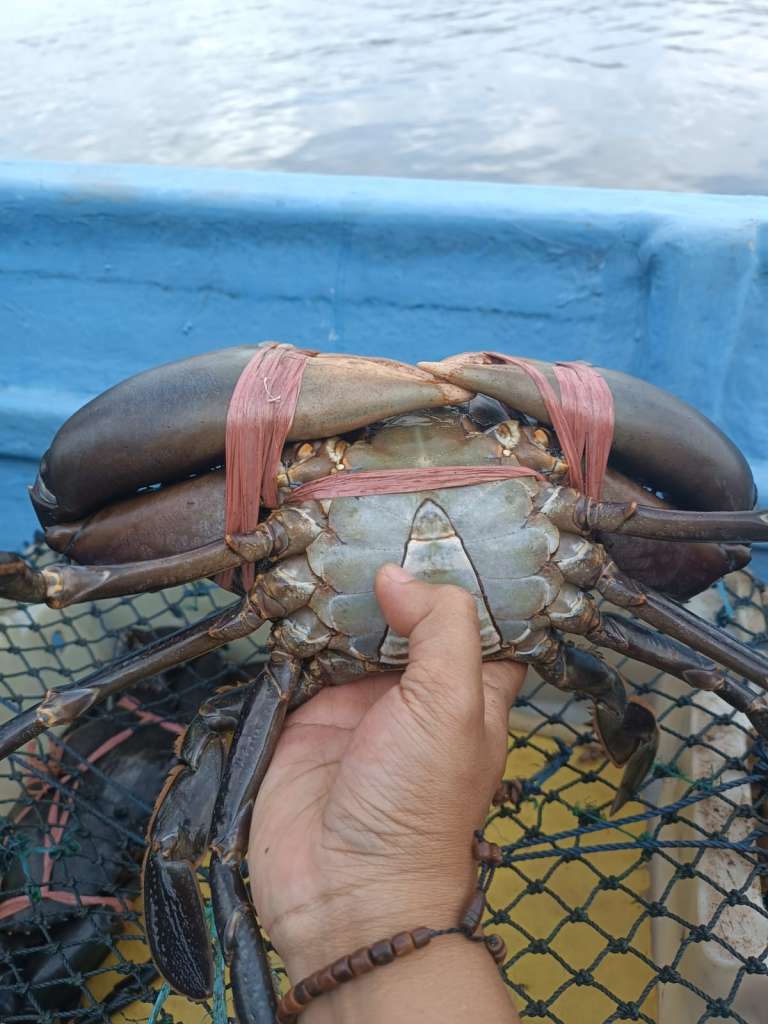
Below the hut, there are 3-4 traditional “kedo-kedo” boats moored to wooden stakes. Behind the hut, there appears to be a former garden with several coconut trees. A wooden bridge connects the hut to the garden, some of its planks already starting to decay. Inside the hut, fishnet traps hang from the ceiling. Here, equipment and spare clothing are stored. Rice, coffee, sugar, and eating utensils are usually available. In the corner, there is a simple stone stove with a wooden grill on top for smoking fish.
This hut serves as a resting and lodging place for Frans Jat when he’s out crabbing. Usually, crabbing activities last for 3-6 days, and he returns to the village on Fridays or Saturdays. After checking all the traps he has set, he returns here to rest until the next day to repeat the same routine.
After releasing two large crabs brought along, the work of checking and setting traps continues. This time, we cannot join as Frans Jat uses a small boat barely wide enough for one person to sit in. With impeccable balance and no space left as the boat is already filled with three traps, Frans Jat calmly rows away from the hut towards smaller straits to check and set more traps.
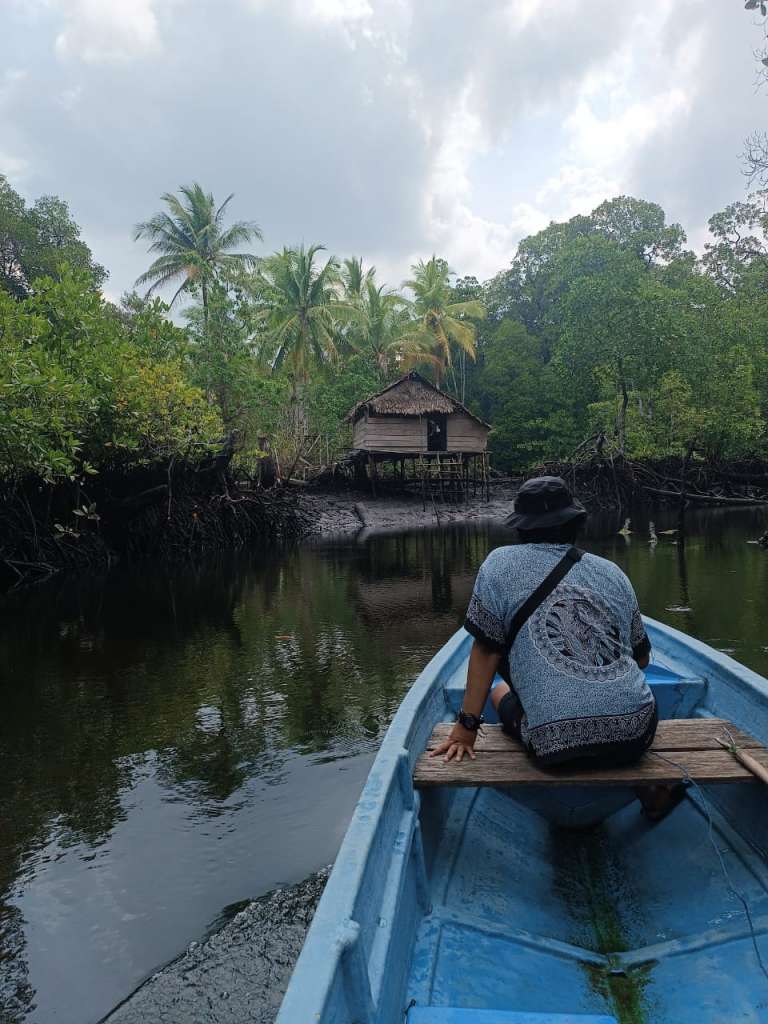
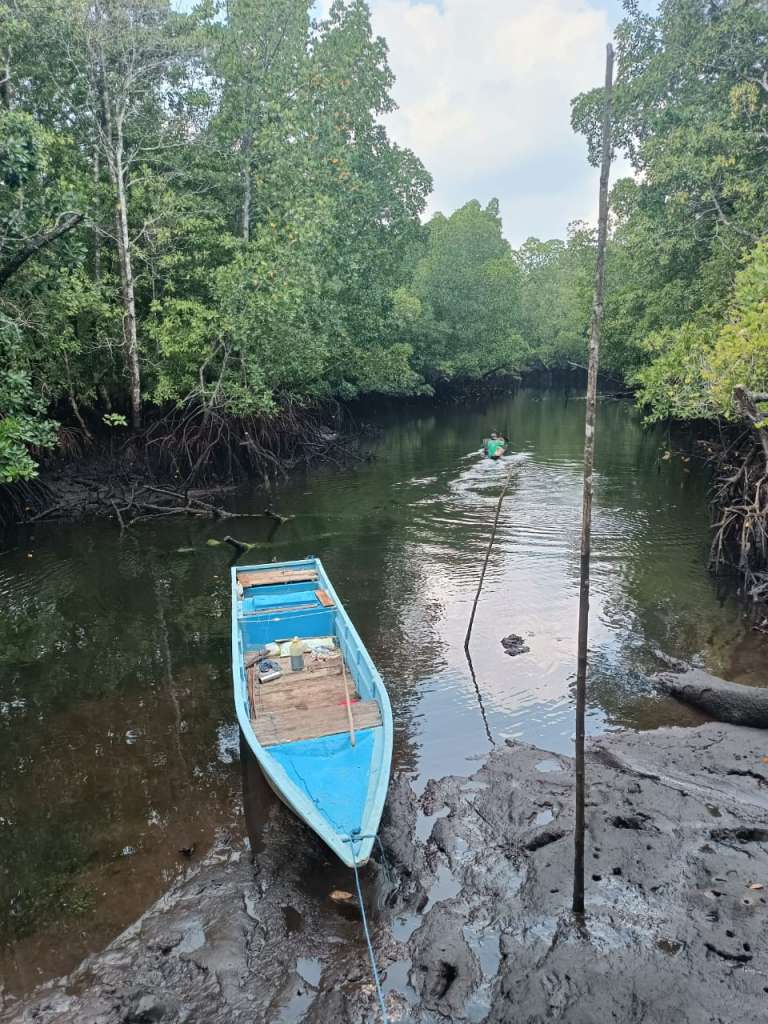
For the people of Lorang, the awareness and knowledge of the trap locations are strong. There are no disputes among residents regarding trap placement, nor any incidents of theft. This is likely because the people of Lorang strongly adhere to the traditional norms in managing natural resources, which have been passed down for generations within their community. The disruption to access to crab and other natural resources in Lorang comes from outsiders.
As the sun begins to set slightly to the west, Frans Jat returns. After mooring his boats to the hut’s stairs, I, curious about the catch, ask, “So, did you catch any crabs?”
With a smile, Frans Jat shakes his head.
Not a single crab caught?! With the time he spent away earlier, it seems unlikely that Frans Jat checked all his traps. Because the number of traps set by crab hunters from Lorang can reach dozens to hundreds. Or perhaps he only went out to set the three traps he brought. Nevertheless, luck once again did not favor him, with no crabs caught today.
Still aboard his boats, Frans Jat offers us coconuts. Without hesitation, we accept his offer. “Wait a moment!” he says.
The boats set off again.
Not long after, he returns with two young coconuts. Swiftly, he peels them with a machete, punches holes in the shells, and hands them to us. Without many words, we drink the coconut water straight from the fruit.
“Ah… This coconut water is so refreshing!” It tastes sweet and delightful. It’s also intriguing how coconut trees growing on narrow land surrounded by salty water can produce such sweet water. We then split the coconuts and scoop out the flesh to eat. Whether it’s because we were hungry, having only had a few slices of bread for breakfast, or the coconuts are simply delicious, it doesn’t take us long to finish them.
After quenching our thirst and satisfying our hunger, Frans Jat suggests heading back to the village. We descend from the hut via the partially submerged stairs, taking careful steps onto the boats.
The boat’s engine starts, and we sit calmly. Shortly after starting to move, Frans Jat casts his fishing line again. Along this strait, we often pass by schools of fairly large fish. They swim in formation, sometimes leaping, then diving into the depths, only to reappear behind our boats after we’ve passed. It’s as if they’re teasing us! Despite seeing many fish, none are caught on our lines.
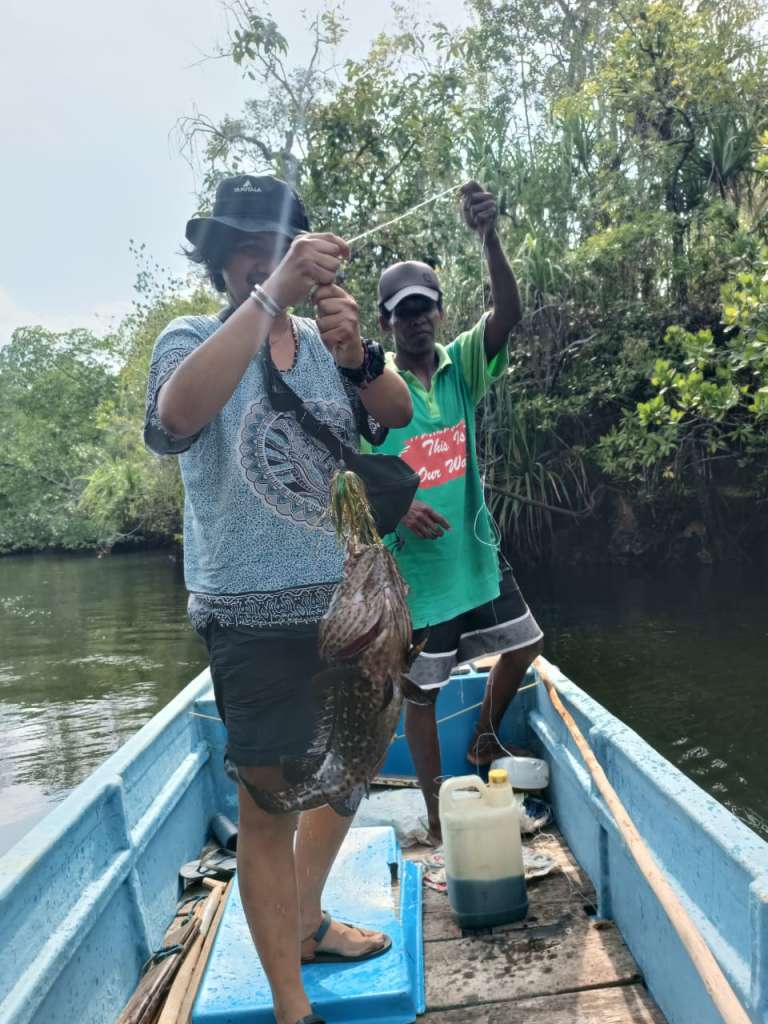
Halfway back to the Lorang village, after passing by seaweed farms, Frans Jat steers his boats into another small strait. For a stranger like me, being left alone in these straits would likely lead to getting lost and not finding the way back. The intersections between small islands look quite similar. These straits separating the small islands aren’t visible from afar and only become clear when approached.
A few meters into this small strait, the scorching sun suddenly feels less intense. Its heat seems blocked by the dense canopy of mangrove trees lining the strait’s edge, providing us shade. The gentle breeze makes us even more comfortable, almost lulling us to sleep.
Until, at a bend in the strait, Frans Jat stops the boats and says to us, “Let’s head back!” Without a word, I nod, smiling wryly. With today’s experience, I feel there’s no need to hope for a catch. The boats then turn around, while Frans Jat continues to fish. Meanwhile, I can only resign myself to today’s fate… hehe.
Sitting on the boats, feeling drowsy, suddenly there’s a tug and Frans Jat’s shout from behind. “Got one!”
Still not fully aware of what’s happening, I turn around while Frans Jat switches off the boat’s motor.
Slowly, he reels in the fishing line, which seems to be moving back and forth. It doesn’t take long before a grouper, with a head the size of two palms, is hoisted onto the boat.
“Alhamdulillah!” This is enough to erase the fatigue of the day, and there’s no shame in returning to the village empty-handed.
We continue the journey home while still fishing. The joy of catching the first fish today hasn’t faded when suddenly Frans Jat stops his boats again. Strike! He pulls the fishing line, and once again, another fish takes the bait. And not long after, another grouper, slightly smaller than the previous one, is lifted aboard.
With little time between catches, this catch makes our hearts yearn for more. However, it seems that this is the last catch we’ll get today, as the day is nearing its end, and we hurry to return home.
In the end, fortune has its limits; it’s up to us to always strive and exert our utmost effort to find it. Today, we return home not empty-handed. The evening sky over the Lorang strait looks even brighter with two large groupers in hand. Lorang… Welcome!



